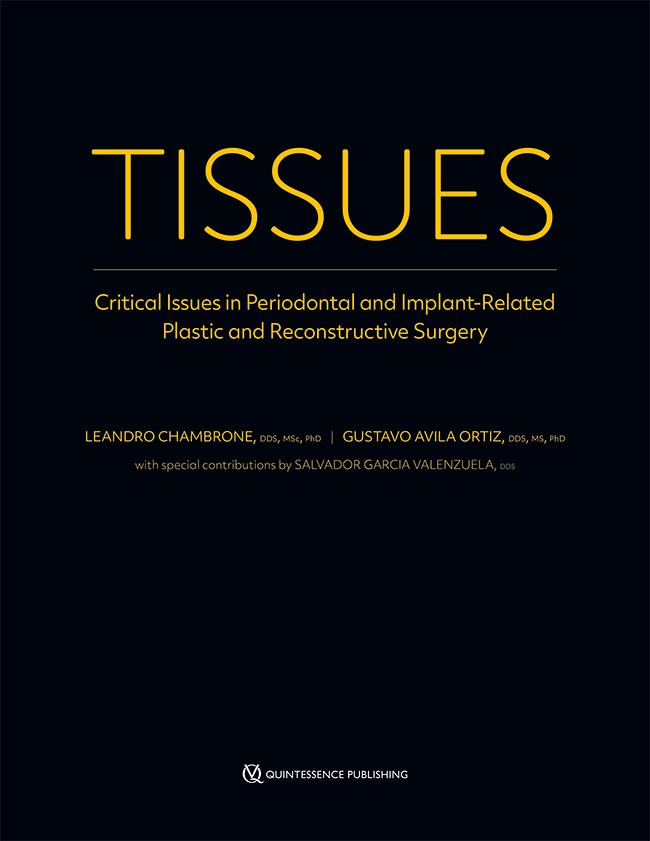International Journal of Periodontics & Restorative Dentistry, Pre-Print
DOI: 10.11607/prd.767230. May 2025,Pages 1-26, Language: EnglishCouso-Queiruga, Emilio / Garaicoa-Pazmino, Carlos / Martin, Kim / Ozgur, Engin / Fonseca, Manrique / Raabe, Clemens / Chappuis, Vivianne / Avila-Ortiz, GustavoThis study evaluated the efficacy of alveolar ridge preservation (ARP) for pontic site development following non-molar maxillary tooth extraction versus unassisted socket healing (USH). Cone beam computed tomography was employed to measure pre-extraction facial bone thickness (FBT). An ideal baseline pontic was digitally pre-designed according to the characteristics of the site before tooth extraction, which was captured with a surface scanner. Post-extraction pontic modifications were analyzed by superimposing baseline and final scans. Additionally, changes in alveolar ridge width, the presence of a buccal soft tissue concavity, and the need for soft tissue augmentation were also assessed. Among 88 patients, USH sites required significantly more pontic modifications and exhibited greater horizontal ridge reduction compared to sites that underwent ARP (P<.001). ARP sites exhibited a lower prevalence of buccal ridge concavity compared to USH (70.5% vs 88.6%, P=.06) and a lower need for soft tissue augmentation (46.5% vs. 70.5%, P=.06). FBT at baseline was strongly negatively associated with more pontic modifications, greater horizontal ridge reduction, and increased need for soft tissue augmentation regardless of the baseline therapy (P<.001), but not with the presence of a buccal soft tissue concavity (P=.06). These findings suggest that ARP therapy effectively mitigates post-extraction dimensional changes, making it a viable approach for pontic site development. However, ancillary soft tissue augmentation may be required in certain cases to achieve optimal therapeutic outcomes.
Keywords: bone resorption, tooth extraction, digital image processing, alveolar ridge preservation
International Journal of Periodontics & Restorative Dentistry, Pre-Print
DOI: 10.11607/prd.778311. Jul 2025,Pages 1-36, Language: EnglishAbrahamian, Lory / Babiano, Álvaro / Avila-Ortiz, Gustavo / Nart, José / Blasi, GonzaloAutogenous grafts are broadly regarded as the gold standard material for soft tissue augmentation in periodontal and implant-related surgery. However, intraoral harvesting of autogenous soft tissue grafts can pose challenges for clinicians due to technical complexity, limited available tissue, and the potential for patient morbidity, among other reasons. This comprehensive review explores key aspects of autogenous connective tissue graft harvesting with a particular focus on approaches involving the de-epithelialization of free masticatory mucosal grafts (DFMMGs), such as the main advantages and disadvantages of extra- and intraoral de-epithelialization, emerging technologies to assist and streamline harvesting, donor site healing dynamics, postoperative pain perception, wound management strategies, and common intra- and postoperative complications.
Keywords: connective tissue, grafts, morbidity, pain, wound healing
International Journal of Periodontics & Restorative Dentistry, Pre-Print
DOI: 10.11607/prd.7265, PubMed ID (PMID): 3905894126. Jul 2024,Pages 1-23, Language: EnglishRodrigues, Diogo Moreira / Avila-Ortiz, Gustavo / Barboza, Eliane Porto / Chambrone, Leandro / Fonseca, Manrique / Couso-Queiruga, EmilioThis study aimed at characterizing the gingival thickness (GT) and determining correlations with other local phenotypical features. Cone-beam computed tomography scans from adult subjects involving the maxillary anterior teeth were obtained to assess buccal GT at different apico-coronal levels, periodontal supracrestal tissue height (STH), the distance from the cementoenamel junction to the alveolar bone crest (CEJ-BC), and bucco-lingual tooth dimensions in mm. A total of 100 subjects and 600 maxillary anterior teeth constituted the study sample. Variations in mean values of GT were observed as a function of apico-coronal level, tooth type, and gender. GT progressively increased apically. Maxillary central incisors and males generally exhibited thicker GT. Contrarily, females exhibited thinner GT and shorter STH. Tooth dimensions were negatively correlated with GT, as the narrower the tooth crown/root in the bucco-lingual dimension, the thicker the gingiva. GT at the level of the CEJ was dichotomized to differentiate between thin (<1mm) and thick (≥1mm) gingival phenotypes (GP). Teeth with a thin GP displayed greater CEJ-BC and buccolingual tooth width dimensions. Conversely, teeth with a thick GP generally exhibited taller STH and narrower tooth dimensions.
International Journal of Periodontics & Restorative Dentistry, Pre-Print
DOI: 10.11607/prd.7217, PubMed ID (PMID): 3943672922. Oct 2024,Pages 1-28, Language: EnglishCouso-Queiruga, Emilio / López del Amo, Fernando Suárez / Avila-Ortiz, Gustavo / Chambrone, Leandro / Monje, Alberto / Galindo-Moreno, Pablo / Garaicoa- Pazmino, CarlosThis PRISMA-compliant systematic review aimed to investigate the effect of supportive peri- implant care (SPIC) on peri-implant tissue health and disease recurrence following the non surgical and surgical treatment of peri-implant diseases. The protocol of this review was registered in PROSPERO (CRD42023468656). A literature search was conducted to identify investigations that fulfilled a set of pre-defined eligibility criteria based on the PICO question: what is the effect of SPIC upon peri-implant tissue stability following non-surgical and surgical interventions for the treatment of peri-implant diseases in adult human subjects? Data on SPIC (protocol, frequency, and compliance), clinical and radiographic outcomes, and other variables of interest were extracted and subsequently categorized and analyzed. A total of 8 studies, with 288 patients and 512 implants previously diagnosed with peri-implantitis were included. No studies including peri-implant mucositis fit the eligibility criteria. Clinical and radiographic outcomes were similar independently of specific SPIC features. Nevertheless, a 3-month recall interval was generally associated with a slightly lower percentage of disease recurrence. The absence of disease recurrence at the final follow-up period (mean of 58.7±25.7 months) ranged between 23.3% and 90.3%. However, when the most favorable definition of disease recurrence reported in the selected studies was used, mean disease recurrence was 28.5% at baseline, considered 1 year after treatment for this investigation, and increased to 47.2% after 2 years of follow-up. In conclusion, regardless of the SPIC interval and protocol, disease recurrence tends to increase over time after the treatment of peri-implantitis, occasionally requiring additional interventions.
Keywords: dental implants; peri-implantitis; peri-implant mucositis; disease progression; risk factors
International Journal of Periodontics & Restorative Dentistry, 4/2025
DOI: 10.11607/prd.2025.4.e Pages 434-435, Language: EnglishChambrone, Leandro / Avila-Ortiz, GustavoEditorial The International Journal of Oral & Maxillofacial Implants, 7/2025
Open Access Supplement Online OnlyDOI: 10.11607/jomi.2025suppl2Pages s49-s72, Language: EnglishLin, Guo-Hao / Chambrone, Leandro / Rajendran, Yogalakshmi / Avila-Ortiz, GustavoPurpose: To assess whether adjunctive treatment modalities offer therapeutic advantages when used in combination with peri-implant debridement—defined as supra- and/or submarginal debridement using manual, sonic, and/or ultrasonic instrumentation—for the treatment of peri-implant mucositis. Materials and Methods: Relevant articles published in English between January 1980 and October 2023 were searched. Clinical trials involving ≥ 10 patients diagnosed with peri-implant mucositis and treated with debridement alone versus debridement plus an adjunctive treatment were included. Data were extracted and meta-analyses were performed to investigate the effect of different therapeutic approaches on several outcomes of interest (ie, pocket depth [PD] and bleeding on probing [BoP] reduction as well as complete disease resolution). Results: A total of 25 articles were selected, of which 19 were included in the meta-analyses. Peri-implant debridement generally resulted in PD and BoP reduction. For studies including nonsmokers or patients with unclear smoking status, outcomes of individual studies revealed that the use of certain probiotics, such as Lactobacillus reuteri strains, may modestly reduce BoP in the short term. For studies exclusively involving smokers or users of vapes/ electronic cigarettes, the clinical benefits of adjunctive therapy were negligible. Complete disease resolution was not consistently achieved regardless of the treatment modality. Conclusions: Peri-implant debridement as a monotherapy for the treatment of peri-implant mucositis generally results in clinical improvements in terms of PD and BoP reduction. The use of adjunctive treatment modalities does not appear to provide a clinically significant additional therapeutic benefit compared to debridement alone, independent of the patient’s smoking status. Complete peri-implant mucositis resolution is an elusive outcome.
Keywords: decontamination, dental implants, meta-analysis, osseointegration, systematic review
International Journal of Periodontics & Restorative Dentistry, 3/2025
DOI: 10.11607/prd.2025.3.c1 Pages 290-292, Language: EnglishLevi, Jr. Paul A. / Yam, Natalie / Kim, David M. / Avila-Ortiz, GustavoCommentary International Journal of Periodontics & Restorative Dentistry, 2/2025
DOI: 10.11607/prd.2025.2.c , PubMed ID (PMID): 40048725Pages 146-151, Language: EnglishRasperini, Giulio / Avila-Ortiz, Gustavo / Pagni, Giorgio / Giannobile, William V.Commentary International Journal of Oral Implantology, 2/2025
Pages 119-133, Language: EnglishTestori, Tiziano / Stacchi, Claudio / Felice, Pietro / Strappa, Enrico M / Gemelli, Charlotte / Clauser, Tommaso / Rapani, Antonio / Saleh, Muhammad H / Avila-Ortiz, Gustavo / Berton, Federico / Bornstein, Michael M / Botticelli, Daniele / Cha, Jae-Kook / Chan, Hsun-Liang / Farina, Roberto / Galindo-Moreno, Pablo / Jung, Ui-Won / Lim, Hyun-Chang / Lombardi, Teresa / Starch-Jensen, Thomas / Stavropoulos, Andreas / Taschieri, Silvio / Thoma, Daniel / Trombelli, Leonardo / Wallace, Stephen / Chiapasco, Matteo / Jensen, Ole T / Lozada, Jaime / Pikos, Michael A / Pistilli, Roberto / Urban, Istvan / Valentini, Pascal / Zuffetti, Francesco / Felisati, Giovanni / Saibene, Alberto / Craig, John R / Wang, Hom-LayPurpose: To achieve a consensus among international experts regarding the management of postoperative complications after maxillary sinus floor elevation. Materials and methods: A total of 32 experts were enrolled and divided into dental implant providers (21), experts with a well-established reputation as sinus specialists (8), ear, nose and throat specialists (2), and experts with a well-established reputation as ear, nose and throat specialists (1). Before starting, a systematic literature search was conducted on the topic, and a list of articles was sent to the panel. The development group formulated 20 statements, which were sent out in the form of a survey. After each round, the statements upon which a consensus was not reached were reformulated based on anonymous comments from participants. A total of three rounds were planned. Results: After the third round, a consensus was reached on 15 key statements regarding the management of postoperative complications following sinus floor elevation. Agreement was established on issues including common postoperative symptoms, use of radiographic assessments, the necessity of surgical interventions such as partial or total graft removal, and the potential need for functional endoscopic sinus surgery. Near-consensus was achieved on additional points concerning normal postoperative symptoms, timing of total graft removal and approaches to late graft infections. Conclusions: The present Delphi consensus suggests that postoperative symptoms such as pain and swelling are generally manageable with appropriate pharmacological treatment. It also outlines conditions where radiographic evaluation is recommended for further assessment. Surgical options, including partial or total graft removal and functional endoscopic sinus surgery, are recommended based on the clinical scenario and response to initial treatments. Variability in practices, particularly regarding antibiotic use and specific intervention timing, suggests a need for further research to be conducted in order to standardise treatment protocols and address gaps in evidence.
Keywords: consensus, maxillary sinusitis, peri-implantitis, sinus floor augmentation
The authors declare there are no conflicts of interest relating to this study.
International Journal of Periodontics & Restorative Dentistry, 1/2025
DOI: 10.11607/prd.6935, PubMed ID (PMID): 37819850Pages 115-133j, Language: EnglishGaraicoa-Pazmino, Carlos / Couso-Queiruga, Emilio / Monje, Alberto / Avila-Ortiz, Gustavo / Castilho, Rogerio M. / Amo, Fernando Suárez López delThe aim of this PRISMA-compliant systematic review was to analyze the evidence pertaining to disease resolution after the treatment of peri-implant diseases with the following PICO question: What is the rate of disease resolution following nonsurgical and surgical therapy for peri-implant diseases in adult human subjects? A literature search to identify studies that fulfilled preestablished eligibility criteria was conducted. Data on primary therapeutic outcomes, including treatment success and rate of disease resolution and/or recurrence, as well as a variety of secondary outcomes were extracted and categorized. A total of 54 articles were included. Few studies investigated the efficacy of different nonsurgical and surgical therapies to treat peri-implant diseases using a set of predefined criteria and with follow-up periods of at least 1 year. The definition of treatment success and disease resolution outcomes differed considerably among the included studies. Peri-implant mucositis treatment was most commonly reported to be successful in arresting disease progression for ≤ 60% of the cases, whereas most studies on peri-implantitis treatment reported disease resolution occurring in < 50% of the implants. Disease resolution is generally unpredictable and infrequently achieved after the treatment of peri-implant diseases. A great variety of definitions have been used to define treatment success. Notably, percentages of treatment success and disease resolution were generally underreported. The use of standardized parameters to evaluate disease resolution should be considered an integral component in future clinical studies.
Keywords: dental implant, diagnosis, peri-implant endosseous healing, peri-implantitis, outcome assessment, tooth loss







